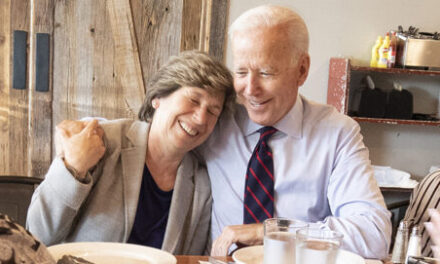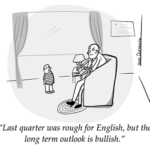An interview with education editor Chrissie Thompson reveals how the USA Today education team has grown and evolved, despite the pandemic and shifts in foundation funding.
By Alexander Russo
What’s it like, building a national education team pretty much from scratch and coordinating with dozens of education reporters at 260 different papers – much of it during a worldwide pandemic?
That’s what USA Today education editor Chrissie Thompson has done over the past couple of years since she joined the paper. The USA Today education page features stories from the national team, network members, and other sections of the paper. And from what I can tell, she and her team have done a standout job.
After dwindling to a single part-time reporter without an education-specific editor, USA Today’s education team has become one of the biggest and arguably best national education desks out there, producing a steady stream of strong work, frequently appearing in The Grade’s “best of the week” newsletter and formally recognized for its excellence.
Launched two years ago with a nearly $500,000 grant from the Bill and Melinda Gates Foundation, the founding team included editor Thompson, K-12 reporter Erin Richards, and higher education reporter Chris Quintana. More recent additions include Lindsay Schnell, who’s helping cover higher education, and former Atlantic education reporter and editor Alia Wong, covering early childhood and K-12.
In the following interview, which has been edited and condensed, Thompson describes how the team has evolved, what some of its challenges have been, and where it’s headed next.
Disclosure: The Grade receives support from the Bill and Melinda Gates Foundation.

Clockwise, starting top left: Chrissie Thompson (editor), Chris Quintana and Loop (Higher Ed), Erin Richards (K-12), Lindsay Schnell (Higher Ed), Alia Wong (Early Childhood/Equity), Elinor Aspegren (intern).
Alexander Russo: What’s your vision for the USA Today education team, and how’s it different from other national education teams?
Chrissie Thompson: Our national team’s mandate is to do really impactful “big J” journalism that illuminates policy and inequities for the average person. Our audience is much more mainstream than some other national publications. We lean into that in terms of being able to explain our journalism in ways that will connect with readers. We joke a lot about ways to get people to read about obscure issues like college accreditation. It’s a big jargony word, but we’ve done it in a way that the average person can understand.
AR: One of the main challenges of the past nine months has been figuring out how to balance COVID-related coverage with reporting on preexisting systemic issues in education. What has your story mix looked like, and how have you balanced the two imperatives?
CT: We have kept our coverage pretty COVID-focused. But the way we’ve covered the pandemic has been as closely focused as possible on inequities – many of them systemic. To me, the short- and long-term implications of the pandemic on students’ education and future, especially students who are every day being left behind, is *the* story of our time.
A good recent piece is Alia’s story on kindergarten readiness. Erin’s stories on special education students (and some stories from the Network on this topic as well) would also fall into this category. [See here and here.]
If we know something’s happening, like that more schools are going online as teachers get COVID, we want to put a headline on that. We would do that maybe more than some of the other national teams would. – Thompson
AR: How does USA Today’s approach to covering education differ from national competitors?
CT: We don’t follow what the education department does in a “paper of record” way. We would be looking more for when those policies affect what’s going on in a local school. We have to make choices, and that’s a choice we’ve made to allow us to focus more on the kind of enterprise that connects with our audience. Another choice we’ve made is to do these broad trend stories. If we know something’s happening, like that more schools are going online as teachers get COVID, we want to put a headline on that. These stories tell readers “Here’s where things are going.” We would do that maybe more than some of the other national teams would.
AR: Some of the standout USA Today pieces that The Grade has featured in its newsletter in recent months include stories on the challenges of providing high-quality remote lessons to students with disabilities, the lack of COVID school case data, and the tentative success of school reopening efforts. Non-COVID stories that have stood out include ones about Black students in the suburbs. What (if anything) do these stories tell us about how you pick stories or how the team works?
CT: First, only half of those stories were written by members of the USAT national team. We really rely on our top-notch local reporters around the country for excellent stories and projects on education trends in their regions. We love to take their local projects national and to collaborate with them for on-the-ground reporting on national trends. Here’s a more recent trend story where Erin collaborated with Lily Altavena in Arizona and Skylar Rispens in Montana.
Second, I think it’s worth noting that these stories represent our attempts to cover big, national stories in a way that others are not. We need to have those signpost stories because we are “the nation’s newspaper.” But we also want to find nuance and angles and trends that our other colleagues in the field haven’t tackled yet, or tell those stories in a way that’s unique to our mainstream audience.
This spring and summer, we were hearing a lot about kids being super-spreaders… But we’ve learned this fall that it’s definitely possible to do in-person school safely – and our data story out of Florida was one of the first, if not the first, major story to show that schools don’t appear to be responsible for increasing community spread. – Thompson
AR: What if any misperceptions are there about the USA TODAY education coverage?
CT: I think the education team is widely respected and doing great journalism. At USAT broadly, given how mainstream it is, we have really strong enterprise and investigative teams, and we also have people whose very important jobs are capturing trending news across the country. We have an audience that trends a little younger than some of our competitors. These are people who are parents. I think that’s really cool. There are stories on our website for everyone.
AR: How is the education team paid for, in terms of salary and other resources?
CT: We were initially funded in part by a grant from the Gates Foundation. The terms of the initial grant have ended Oct. 1. We are in discussion with Gates about future possibilities. However, we have since entered into a grant with Save The Children, an international nonprofit in part focused on early education in rural America. They are funding some of our early childhood education reporting, which is a huge priority of ors coming out of the pandemic. That grant will fund part of Alia’s salary. All four of our reporters and our intern Elinor Aspegren are funded through the newsroom budget, which shows the priority USAT has placed on education reporting. Their salaries are not dependent on the grant, though it is a very nice thing to have.
AR: Education journalism has been criticized for underemphasizing the deficiencies of remote learning and amplifying the fears and risks of returning to in-person schooling. How have you and your team addressed these challenges, and looking back how’d you do?
CT: I think our coverage has morphed a bit as the information coming from the nation’s health and education experts has evolved. This spring and summer, we were hearing a lot about kids being super-spreaders and a lot of warnings about the dangers of reopening schools when community spread was not under control. We wrote about that second issue especially, holding schools and government leaders accountable for not having clear plans for handling outbreaks or clear standards for re-closing schools.
But we’ve learned this fall that it’s definitely possible to do in-person school safely – and our data story out of Florida was one of the first, if not the first, major story to show that schools don’t appear to be responsible for increasing community spread of COVID-19. Also, I’m really proud of Erin Richards’ summer project on the lack of attention being given by schools to improving remote learning. Stay tuned for more on this subject.
AR: What do you wish you’d known from the start? What have you learned along the way?
CT: I really believe that we needed to have early childhood reporting as part of the education team. The initial positions were driven in part by our grant. So, I’m really glad we were able to make some adjustments to our expanded team so early childhood education is something we can own.
Related coverage from The Grade
How the Seattle Times education team covered the COVID-19 crisis
Assessing the surge in Boston-area education coverage
Coverage challenges in the coronavirus era
ABOUT THE AUTHOR

Alexander Russo
Alexander Russo is founder and editor of The Grade, an award-winning effort to help improve media coverage of education issues. He’s also a Spencer Education Journalism Fellowship winner and a book author. You can reach him at @alexanderrusso.
Visit their website at: https://the-grade.org/












